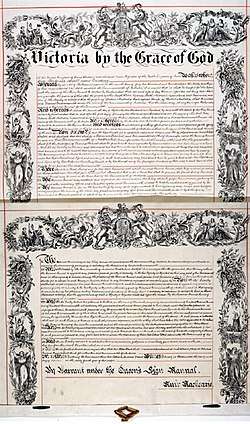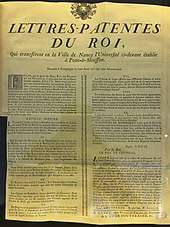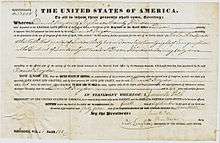Letters patent
Letters patent (always in the plural) are a type of legal instrument in the form of a published written order issued by a monarch, president, or other head of state, generally granting an office, right, monopoly, title, or status to a person or corporation. Letters patent can be used for the creation of corporations or government offices, or for the granting of city status or a coat of arms. Letters patent are issued for the appointment of representatives of the Crown, such as governors and governors-general of Commonwealth realms, as well as appointing a Royal Commission. In the United Kingdom they are also issued for the creation of peers of the realm. A particular form of letters patent has evolved into the modern patent (referred to as a utility patent or design patent in United States patent law) granting exclusive rights in an invention (or a design in the case of a design patent). In this case it is essential that the written grant should be in the form of a public document so other inventors can consult it to avoid infringement and also to understand how to "practice" the invention, i.e., put it into practical use. In the Holy Roman Empire, Austrian Empire, and Austria-Hungary, imperial patent was also the highest form of generally binding legal regulations, e. g. Patent of Toleration, Serfdom Patent etc.


The opposite of letters patent are letters close (Latin: litterae clausae), which are personal in nature and sealed so that only the recipient can read their contents. Letters patent are thus comparable to other kinds of open letter in that their audience is wide. It is not clear how the contents of letters patent became widely published before collection by the addressee, for example whether they were left after sealing by the king for inspection during a certain period by courtiers in a royal palace, who would disseminate the contents back to the gentry in the shires through normal conversation and social intercourse. Today, for example, it is a convention for the British prime minister to announce that they have left a document they wish to enter the public domain "in the library of the House of Commons", where it may be freely perused by all members of parliament.
Meaning
Letters patent are so named from the Latin verb pateo, to lie open, exposed, accessible.[1] The originator's seal was attached pendent from the document, so that it did not have to be broken in order for the document to be read.
Litterae in Latin meant "that which is written" or "writing", in the sense of letters of the alphabet placed together in meaningful sequence on a writing surface, not a specific format of composition as the modern word "letter" suggests. Thus letters patent do not equate to an open letter but rather to any form of document, deed, contract, letter, despatch, edict, decree, epistle etc.[2] made public.
They are called "letters" (plural) from their Latin name litterae patentes, used by medieval and later scribes when the documents were written in Latin. This loanword preserves the collective plural "letters" (litterae) Latin language uses to denote a message as opposed to a single alphabet letter (littera).[3]
Usage
Letters patent are a form of open or public proclamation[4] and a vestigial exercise of extra-parliamentary power by a monarch or president. Prior to the establishment of Parliament, the monarch ruled absolutely by the issuing of his personal written orders, open or closed.
They can thus be contrasted with the Act of Parliament, which is in effect a written order by Parliament involving assent by the monarch in conjunction with its members. No explicit government approval is contained within letters patent, only the seal or signature of the monarch.
Parliament today tolerates only a very narrow exercise of the royal prerogative by issuance of letters patent, and such documents are issued with prior informal government approval, or indeed are now generated by government itself with the monarch's seal affixed as a mere formality. In their original form they were simply written instructions or orders from the sovereign, whose order was law, which were made public to reinforce their effect.
For the sake of good governance, it is of little use if the sovereign appoints a person to a position of authority but does not at the same time inform those over whom such authority is to be exercised of the validity of the appointment.
According to the United Kingdom Ministry of Justice, there are 92 different types of letters patent.[5] The Patent Rolls are made up of office copies of English (and later United Kingdom) royal letters patent, which run in an almost unbroken series from 1201 to the present day, with most of those to 1625 having been published.
Form of British letters patent creating peers
The form of letters patent for creating peerages has been fixed by the Crown Office (Forms and Proclamations Rules) Order 1992 (SI 1992/1730). Part III of the schedule lays down nine pro forma texts for creating various ranks of the peerage, lords of appeal in ordinary, and baronets.
The following table organises the text from the letters patent by columns for each rank, with common text spanning multiple columns, depicting some of the similarities and differences among the proclamations. Gender-specific differences are highlighted in italics.
| Dukes and duchesses | Marquesses and marchionesses | Earls and countesses | Viscounts | Hereditary barons | Life barons | Life baronesses | Baronets | Lords of Appeal in Ordinary (now abolished) |
|---|---|---|---|---|---|---|---|---|
| "ELIZABETH THE SECOND by the Grace of God of the United Kingdom of Great Britain and Northern Ireland and of Our other Realms and Territories Queen Head of the Commonwealth Defender of the Faith To all Lords Spiritual and Temporal and all other Our Subjects whatsoever to whom these Presents shall come, Greeting! | ||||||||
| Know Ye that We of Our especial grace certain knowledge and mere motion | Whereas Our (name of grantee in relevant courtly language) has resigned his Office of a Lord of Appeal in Ordinary and the same is now vacant Now Know Ye that We of Our especial grace have in pursuance of the Appellate Jurisdiction Act 1876 as amended by subsequent enactments nominated and appointed and by these Presents Do nominate and appoint Our (name of grantee in relevant courtly language) to be a | |||||||
| in pursuance of the Life Peerages Act 1958 and of all other powers in that behalf us enabling[6] | ||||||||
do by these Presents advance create and prefer Our:[7]
‡ if Privy Councillor to the state degree style dignity title and honour of |
do by these Presents erect appoint and create Our (name of grantee in relevant courtly language) to the dignity state and degree of a | |||||||
| DUKE OF <PLACE>. | MARQUESS OF <PLACE>. | EARL <NAME/NAME OF PLACE/OF PLACE>. | VISCOUNT <NAME> (OF <PLACE>) of <SOMEWHERE> in <COUNTY>. | BARON <NAME> (OF <PLACE>) of <SOMEWHERE> in <COUNTY>. | BARON <NAME> (OF <PLACE>) of <SOMEWHERE> in <COUNTY>. | BARONESS <NAME> (OF <PLACE>) of <SOMEWHERE> in <COUNTY>. | BARONET | LORD OF APPEAL IN ORDINARY |
| And for Us Our heirs and successors do appoint give and grant unto him the said name state degree style dignity title and honour of | by the style of | |||||||
| Duke of <PLACE> | Marquess of <PLACE> | Earl <NAME/NAME OF PLACE/OF PLACE> | Viscount <NAME> (of <PLACE>) | Baron <NAME> (of <PLACE>) | Baroness <NAME> (OF <PLACE>) | Baronet | BARON | |
| and by these Presents do dignify invest and ennoble him by girding him with a sword and putting a cap of honour and a coronet of gold on his head [or, if the grant is to a woman, "dignify invest and really ennoble her with such name state degree title and honour of Duchess/Marchioness/Countess of <PLACE>"] | ||||||||
| and by giving into his hand a rod of gold | ||||||||
| to have and to hold | To hold | |||||||
| the said name state degree style dignity title and honour of | the said name degree style dignity title and honour of | the said Office | ||||||
| Duke of | Marquess of | Earl | ||||||
| unto him and the heirs male of his body lawfully begotten and to be begotten. | unto him for his life. | unto her for her life. | unto him and the heirs male of his body lawfully begotten and to be begotten. | so long as he shall well behave himself therein subject to the provisions in the said Act mentioned | ||||
| Willing and by these Presents granting for Us Our heirs and successors that he | ||||||||
| and his heirs male aforesaid and every of them successively | and his heirs male aforesaid | |||||||
| [may have hold and possess a seat place and voice in the Parliaments and Public Assemblies and Councils of Us Our heirs and successors within Our United Kingdom amongst the] | ||||||||
| [Dukes] | [Marquesses] | [Earls] | [Viscounts] | [Barons] | ||||
| [And also that he] | ||||||||
| [and his heirs male aforesaid successively] | ||||||||
| may enjoy and use all the rights privileges | with all wages profits privileges rank and precedence whatsoever to the said Office belonging or in anywise appertaining and to hold the said style of Baron unto him the said during his life. | |||||||
| pre-eminences immunities | precedences | |||||||
| and advantages to the degree of | ||||||||
| a Duke | a Marquess | an Earl | a Viscount | a Baron | a Baronet | |||
| duly and of right belonging which | ||||||||
| Dukes | Marquesses | Earls | Viscounts | Barons | Baronets | |||
| of Our United Kingdom [have heretofore used and enjoyed or as they] do at present use and enjoy. | ||||||||
| In Witness whereof We have caused these Our Letters to be made Patent. WITNESS Ourself at Westminster the nth day of <MONTH> in the xth year of Our Reign" | ||||||||
The words "may have hold and possess" to "his heirs male aforesaid successively" and "have heretofore used and enjoyed or as they" (shown in brackets above) were deleted for Dukes and Duchesses, Marquesses and Marchionesses, Earls and Countesses, Viscounts, and hereditary Barons by the Crown Office (Forms and Proclamations Rules) (Amendment) Order 2000.[8]
Commonwealth realms
In Commonwealth realms, letters patent are issued under the prerogative powers of the head of state, as an executive or royal prerogative. They are a rare, though significant, form of legislation which does not require the consent of parliament. Letters patent may also be used to grant royal assent to legislation.
In the United States

The primary source of letters patent in the United States are intellectual property patents and land patents, though letters patent are issued for a variety of other purposes. They function dually as public records and personal certificates.
In the United States, the forgery of letters patent granted by the President is a crime subject to fine, imprisonment up to ten years or both (18 U.S.C. § 497). Without letters patent, a person is unable to assume an appointed office. Such an issue prompted the Marbury v. Madison suit, where William Marbury and three others petitioned the United States Supreme Court to order James Madison to deliver their letters for appointments made under the previous administration.
Form of United States letters patent
United States letters patent generally do not fit a specific form, except for the eschatocol, or formal ending:
| IN TESTIMONY WHEREOF, the undersigned [public official], in accordance with [relevant law], has in the name of the United States, Caused these letters to be made Patent and the Seal of [relevant agency or government official] to be hereunto affixed.
GIVEN under my hand, in [city] the [date] in the year of our Lord [year] and of the Independence of the United States the [years since July 4, 1776]. By [signature of public official issuing letter] |
See also
- Commissioning scroll
- Land patent, in the United States
- Letter of marque
- Letters close
- Lettre de cachet
- Exequatur
- List of types of letters patent (British monarchy)
- Papal bull, a type of letters patent issued by a Pope
- Patent, granting rights for an invention
- Patent of Toleration
- Royal Charter
- Statute of Monopolies 1623, an attempt to rein in the abuse of letters patent in England
References
- Cassell's Latin Dictionary, revised by Marchant & Charles, 260th. thousand
- Cassell's Latin Dictionary, op.cit., p.321
- Cassell's Latin Dictionary, revised by Marchant & Charles, 260th. thousand: "Literae, Plur: that which is written; Cicero: Dare alicui literas (plur) ad aliquem: to give to a messenger a letter for a third person"
- E.g. document dated 13 July 1527 issued Teste Rege titled: "A Proclamation for establishing of trade and merchandizing and traffique within the towne and marches of Callice with divers immunities and freedoms concerning the same", which is self-referenced in the document by the phrase "by theis his lettres patentes of proclamacion" Nichols, John Gough. The Chronicle of Calais from the Reigns of Henry VII and Henry VIII to the year 1540, London, 1846 p.102
- "Letter from Sarah Whiteside to Steve Elibank regarding Freedom of Information Request". whatdotheyknow.com. 28 May 2012. Retrieved 16 August 2018.
- "The Crown Office (Forms and Proclamations Rules) Order 1992". legislation.gov.uk.
- "Archived copy". Archived from the original on 25 January 2013. Retrieved 23 August 2012.CS1 maint: archived copy as title (link)
- Crown Office (Forms and Proclamations Rules)(Amendment) Order 2000.
External links
| Wikimedia Commons has media related to Letters patent. |